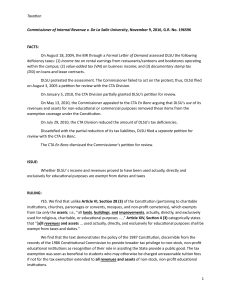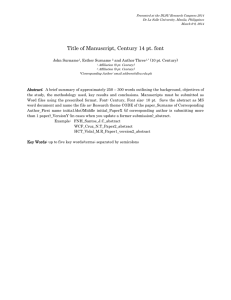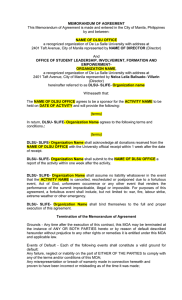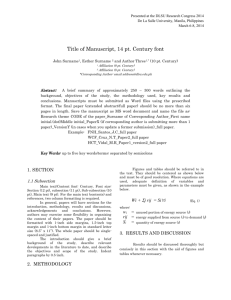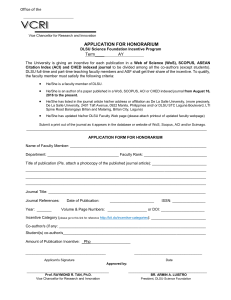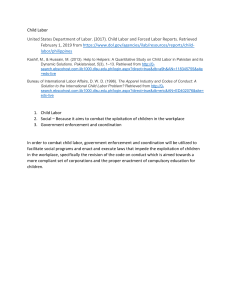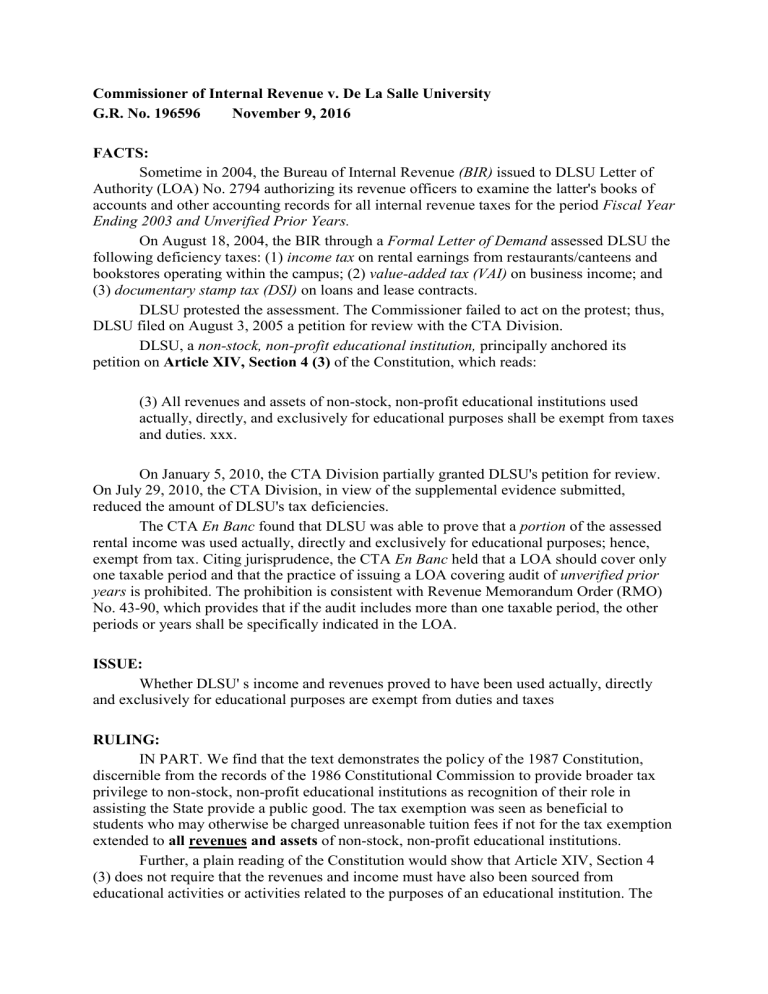
Commissioner of Internal Revenue v. De La Salle University G.R. No. 196596 November 9, 2016 FACTS: Sometime in 2004, the Bureau of Internal Revenue (BIR) issued to DLSU Letter of Authority (LOA) No. 2794 authorizing its revenue officers to examine the latter's books of accounts and other accounting records for all internal revenue taxes for the period Fiscal Year Ending 2003 and Unverified Prior Years. On August 18, 2004, the BIR through a Formal Letter of Demand assessed DLSU the following deficiency taxes: (1) income tax on rental earnings from restaurants/canteens and bookstores operating within the campus; (2) value-added tax (VAI) on business income; and (3) documentary stamp tax (DSI) on loans and lease contracts. DLSU protested the assessment. The Commissioner failed to act on the protest; thus, DLSU filed on August 3, 2005 a petition for review with the CTA Division. DLSU, a non-stock, non-profit educational institution, principally anchored its petition on Article XIV, Section 4 (3) of the Constitution, which reads: (3) All revenues and assets of non-stock, non-profit educational institutions used actually, directly, and exclusively for educational purposes shall be exempt from taxes and duties. xxx. On January 5, 2010, the CTA Division partially granted DLSU's petition for review. On July 29, 2010, the CTA Division, in view of the supplemental evidence submitted, reduced the amount of DLSU's tax deficiencies. The CTA En Banc found that DLSU was able to prove that a portion of the assessed rental income was used actually, directly and exclusively for educational purposes; hence, exempt from tax. Citing jurisprudence, the CTA En Banc held that a LOA should cover only one taxable period and that the practice of issuing a LOA covering audit of unverified prior years is prohibited. The prohibition is consistent with Revenue Memorandum Order (RMO) No. 43-90, which provides that if the audit includes more than one taxable period, the other periods or years shall be specifically indicated in the LOA. ISSUE: Whether DLSU' s income and revenues proved to have been used actually, directly and exclusively for educational purposes are exempt from duties and taxes RULING: IN PART. We find that the text demonstrates the policy of the 1987 Constitution, discernible from the records of the 1986 Constitutional Commission to provide broader tax privilege to non-stock, non-profit educational institutions as recognition of their role in assisting the State provide a public good. The tax exemption was seen as beneficial to students who may otherwise be charged unreasonable tuition fees if not for the tax exemption extended to all revenues and assets of non-stock, non-profit educational institutions. Further, a plain reading of the Constitution would show that Article XIV, Section 4 (3) does not require that the revenues and income must have also been sourced from educational activities or activities related to the purposes of an educational institution. The phrase all revenues is unqualified by any reference to the source of revenues. Thus, so long as the revenues and income are used actually, directly and exclusively for educational purposes, then said revenues and income shall be exempt from taxes and duties. Revenues consist of the amounts earned by a person or entity from the conduct of business operations. It may refer to the sale of goods, rendition of services, or the return of an investment. Revenue is a component of the tax base in income tax, VAT, and local business tax (LBT). Assets, on the other hand, are the tangible and intangible properties owned by a person or entity. It may refer to real estate, cash deposit in a bank, investment in the stocks of a corporation, inventory of goods, or any property from which the person or entity may derive income or use to generate the same. In Philippine taxation, the fair market value of real property is a component of the tax base in real property tax (RPT). Also, the landed cost of imported goods is a component of the tax base in VAT on importation and tariff duties. Thus, when a non-stock, non-profit educational institution proves that it uses its revenues actually, directly, and exclusively for educational purposes, it shall be exempted from income tax, VAT, and LBT. On the other hand, when it also shows that it uses its assets in the form of real property for educational purposes, it shall be exempted from RPT. To be clear, proving the actual use of the taxable item will result in an exemption, but the specific tax from which the entity shall be exempted from shall depend on whether the item is an item of revenue or asset. To illustrate, if a university leases a portion of its school building to a bookstore or cafeteria, the leased portion is not actually, directly and exclusively used for educational purposes, even if the bookstore or canteen caters only to university students, faculty and staff. The leased portion of the building may be subject to real property tax, as held in Abra Valley College, Inc. v. Aquino. We ruled in that case that the test of exemption from taxation is the use of the property for purposes mentioned in the Constitution. We also held that the exemption extends to facilities which are incidental to and reasonably necessary for the accomplishment of the main purposes. In concrete terms, the lease of a portion of a school building for commercial purposes, removes such asset from the property tax exemption granted under the Constitution. There is no exemption because the asset is not used actually, directly and exclusively for educational purposes. The commercial use of the property is also not incidental to and reasonably necessary for the accomplishment of the main purpose of a university, which is to educate its students. However, if the university actually, directly and exclusively uses for educational purposes the revenues earned from the lease of its school building, such revenues shall be exempt from taxes and duties. The tax exemption no longer hinges on the use of the asset from which the revenues were earned, but on the actual, direct and exclusive use of the revenues for educational purposes. Parenthetically, income and revenues of non-stock, non-profit educational institution not used actually, directly and exclusively for educational purposes are not exempt from duties and taxes. To avail of the exemption, the taxpayer must factually prove that it used actually, directly and exclusively for educational purposes the revenues or income sought to be exempted. The crucial point of inquiry then is on the use of the assets or on the use of the revenues. These are two things that must be viewed and treated separately. But so long as the assets or revenues are used actually, directly and exclusively for educational purposes, they are exempt from duties and taxes. DLSU used actually, directly, and exclusively for educational purposes a portion of its assessed income. To see how the CTA arrived at its factual findings, we review the process undertaken, from which it deduced that DLSU successfully proved that it used actually, directly and exclusively for educational purposes a portion of its rental income. The CTA reduced DLSU' s deficiency income tax and VAT liabilities in view of the submission of the supplemental evidence, which consisted of statement of receipts, statement of disbursement and fund balance and statement of fund changes. These documents showed that DLSU borrowed ₱93.86 Million, which was used to build the university's Sports Complex. Based on these pieces of evidence, the CTA found that DLSU' s rental income from its concessionaires were indeed transmitted and used for the payment of this loan. The CTA held that the degree of preponderance of evidence was sufficiently met to prove actual, direct and exclusive use for educational purposes. The CTA also found that DLSU's rental income from other concessionaires, which were allegedly deposited to a fund (CF-CPA Account), intended for the university's capital projects, was not proved to have been used actually, directly and exclusively for educational purposes. The CTA observed that "[DLSU] ... failed to fully account for and substantiate all the disbursements from the [fund]." Thus, the CTA "cannot ascertain whether rental income from the [other] concessionaires was indeed used for educational purposes."
